Angiography
An Angiogram is an X-ray picture of the inside of blood vessels. A long slender tube called a
catheter is inserted into an artery. The catheter is threaded through the artery until its tip
reaches the segment of vessel to be examined.
These vessels can be those of the heart (coronary
angiogram) or other parts of the body. This reveals any narrowing or blockages of the arteries and
other abnormalities.
Peripheral and Percutaneous Coronary Intervention (PCI)
This is a non-surgical method performed to open narrowed or blocked arteries. It is performed by
inserting a catheter through the skin into an artery.
At the leading tip of this catheter, several
different devices such as a balloon, stent, or cutting device can be deployed to open up the narrow
or blocked artery. Blockages or narrowing of coronary arteries and those of the legs, are commonly
treated in this manner.

Loop Recorder Insertion
In people who have infrequently occurring heart rhythm disturbances, a small device can be implanted
under the skin on the chest which records the ECG like a Holter monitor.
Pacemaker Insertion
A Pacemaker is a battery-operated device that is implanted under the skin with wires that make contact
inside the heart. It sends electrical pulses that keep the heart beating regularly.
ICD Insertion
An Internal Cardiac Defibrillator (ICD) is a special pacemaker with 1 or 2 leads. These leads are used
to monitor the heart rhythm and when it becomes very erratic or too rapid, the ICD delivers a shock to
the heart to put it back to normal.
CRT/D Insertion
Cardiac Resynchronization Therapy (CRT) is insertion of a special pacemaker that has 3 wires leading into
the heart instead of the usual 1 or 2.
It is used in patients with heart failure who have heart muscle
that contracts out of sync. It synchronises the muscle contraction and makes the heart work more efficiently.
A CRTD is a CRT pacemaker with a defibrillator.
Right and Left Heart Catheterization
In this procedure, a catheter is put into a blood vessel and advanced to various chambers of the heart to
measure pressures and occasionally, oxygen content of the blood.
Venous Ablation
In this procedure, a laser or radio-ablation catheter is used to shut down large veins in the legs that
are responsible for causing varicose veins. This cures pain swelling and ulceration caused by the varicose
veins.
